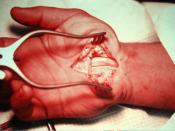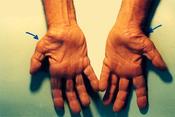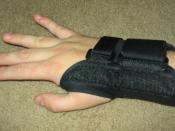For months Gary Smith tried to ignore the tingling and numbing feelings he had been experiencing. Once in awhile a piercing sharp pain would shoot through his wrist and up his forearm. Eventually he had gone to the doctors to see what was wrong. The Doctor informed him he had Carpal Tunnel Syndrome. This injury can happen in many different situations but is very common amongst sport injuries. Carpal tunnel syndrome occurs in the wrist and includes the median nerve. This injury originates from the compression of the median nerve and swelling tendons.
ANATOMICAL AND PHYSIOLOGICAL DESCRIPTION
In the wrist there is a band known as the carpal tunnel, which is limited in size. It is also known as the carpal ligament(Appendix, fig 1). The components of the hand that run through the carpal tunnel are tendons and median nerve. The carpal tunnel is formed by the ligament on top and the carp wrist bones on bottom.
There are several factors that take or restrict the space within this band, causing pressure against the components. When the median nerve gets compressed or squeezed along with the tendons it causes carpal tunnel syndrome. The median nerve provides sensation to most of the hand except for the little finger. The tendons control the movement of fingers (Appendix, fig 2). This injury is considered a chronic injury if untreated. Therefore it is also an acute injury if surgery is performed (National Institute of Neurological Disorders and Stroke,WWW,article). The symptoms of carpal tunnel start out normal and continue to intensify as the nerve and tendons get further compressed. It begins with tingling and numbness in the thumb, index and middle fingers. Frequent burning or itching sensations and loss of grip follows. A radiating pain travels from the wrist up the arm...


